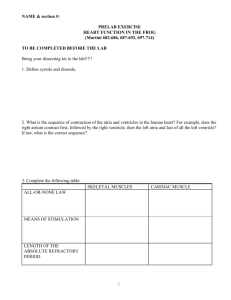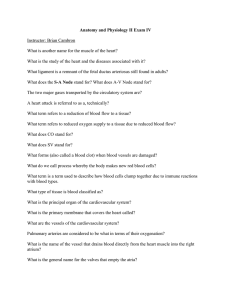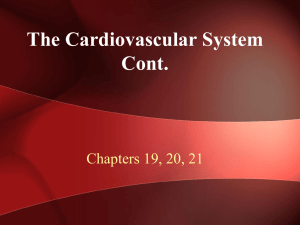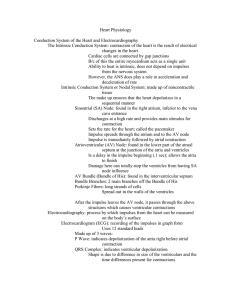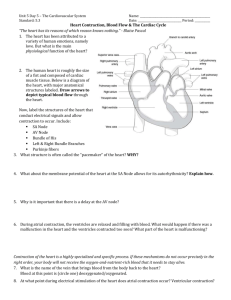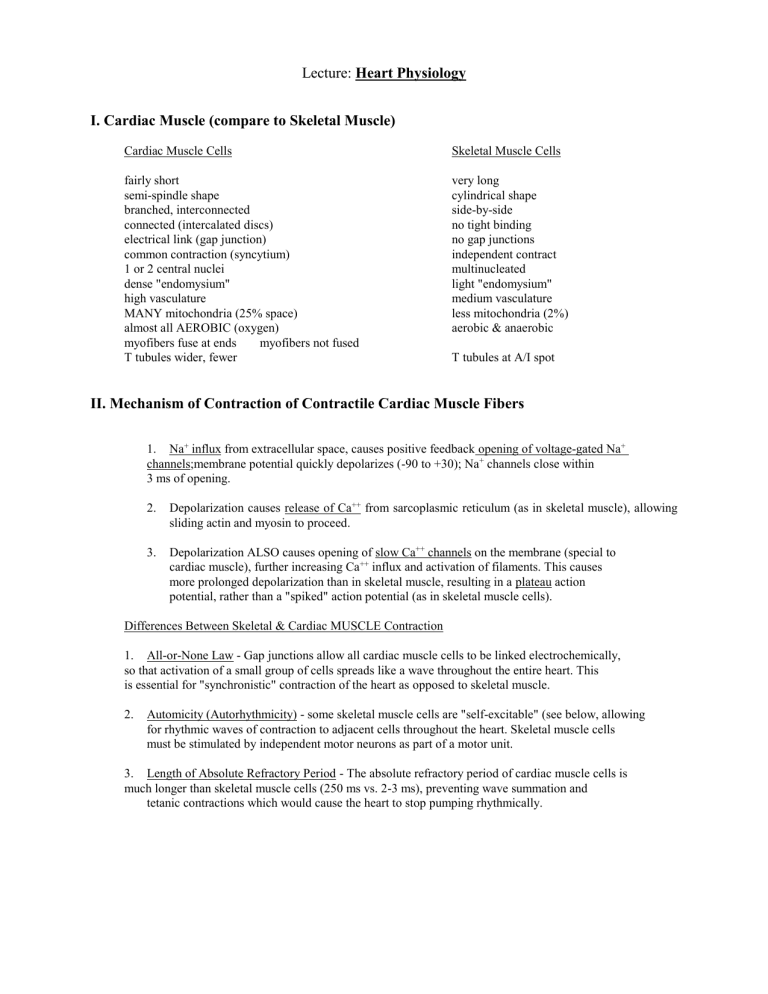
Lecture: Heart Physiology I. Cardiac Muscle (compare to Skeletal Muscle) Cardiac Muscle Cells Skeletal Muscle Cells fairly short semi-spindle shape branched, interconnected connected (intercalated discs) electrical link (gap junction) common contraction (syncytium) 1 or 2 central nuclei dense "endomysium" high vasculature MANY mitochondria (25% space) almost all AEROBIC (oxygen) myofibers fuse at ends myofibers not fused T tubules wider, fewer very long cylindrical shape side-by-side no tight binding no gap junctions independent contract multinucleated light "endomysium" medium vasculature less mitochondria (2%) aerobic & anaerobic T tubules at A/I spot II. Mechanism of Contraction of Contractile Cardiac Muscle Fibers 1. Na+ influx from extracellular space, causes positive feedback opening of voltage-gated Na+ channels;membrane potential quickly depolarizes (-90 to +30); Na+ channels close within 3 ms of opening. 2. Depolarization causes release of Ca++ from sarcoplasmic reticulum (as in skeletal muscle), allowing sliding actin and myosin to proceed. 3. Depolarization ALSO causes opening of slow Ca++ channels on the membrane (special to cardiac muscle), further increasing Ca++ influx and activation of filaments. This causes more prolonged depolarization than in skeletal muscle, resulting in a plateau action potential, rather than a "spiked" action potential (as in skeletal muscle cells). Differences Between Skeletal & Cardiac MUSCLE Contraction 1. All-or-None Law - Gap junctions allow all cardiac muscle cells to be linked electrochemically, so that activation of a small group of cells spreads like a wave throughout the entire heart. This is essential for "synchronistic" contraction of the heart as opposed to skeletal muscle. 2. Automicity (Autorhythmicity) - some skeletal muscle cells are "self-excitable" (see below, allowing for rhythmic waves of contraction to adjacent cells throughout the heart. Skeletal muscle cells must be stimulated by independent motor neurons as part of a motor unit. 3. Length of Absolute Refractory Period - The absolute refractory period of cardiac muscle cells is much longer than skeletal muscle cells (250 ms vs. 2-3 ms), preventing wave summation and tetanic contractions which would cause the heart to stop pumping rhythmically. III. Internal Conduction (Stimulation) System of the Heart A. General Properties of Conduction 1. heart can beat rhythmically without nervous input 2. nodal system (cardiac conduction system) - special autorhythmic cells of heart that initiate impulses for wave-like contraction of entire heart (no nervous stimulation needed for these) 3. gap junctions - electrically couple all cardiac muscle cells so that depolarization sweeps across heart in sequential fashion from atria to ventricles B. "Pacemaker" Features of Autorhythmic Cells 1. pacemaker potentials - "autorhythmic cells" of heart muscle create action potentials in rhythmic fashion; this is due to unstable resting potentials which slowly drift back toward threshold voltage after repolarization from a previous cycle. Theoretical Mechanism of Pacemaker Potential: a. K+ leak channels allow K+ OUT of the cell more slowly than in skeletal muscle b. Na+ slowly leaks into cell, causing membrane potential to slowly drift up to the threshold to trigger Ca++ influx from outside (-40 mv) c. when threshold for voltage-gated Ca++ channels is reached (-40 mv), fast calcium channels open, permitting explosive entry of Ca++ from of the cell, causing sharp rise in level of depolarization d. when peak depolarization is achieved, voltage-gated K+ channels open, causing repolarization to the "unstable resting potential" e. cycle begins again at step a. C. Anatomical Sequence of Excitation of the Heart 1. Autorhythmic Cell Location & Order of Impulses (right atrium) sinoatrial node (SA) -> (right AV valve) atrioventricular node (AV) -> atrioventricular bundle (bundle of His) -> right & left bundle of His branches -> Purkinje fibers of ventricular walls (from SA through complete heart contraction = 220 ms = 0.22 s) a. sinoatrial node (SA node) "the pacemaker" - has the fastest autorhythmic rate (70-80 per minute), and sets the pace for the entire heart; this rhythm is called the sinus rhythm; located in right atrial wall, just inferior to the superior vena cava b. atrioventricular node (AV node) - impulses pass from SA via gap junctions in about 40 ms.; impulses are delayed about 100 ms to allow completion of the contraction of both atria; located just above tricuspid valve (between right atrium & ventricle) c. atrioventricular bundle (bundle of His) - in the interATRIAL septum (connects L and R atria) d. L and R bundle of His branches - within the interVENTRICULAR septum (between L and R ventricles) e. Purkinje fibers - within the lateral walls of both the L and R ventricles; since left ventricle much larger, Purkinjes more elaborate here; Purkinje fibers innervate "papillary muscles" before ventricle walls so AV can valves prevent backflow D. Special Considerations of Wave of Excitation 1. initial SA node excitation causes contraction of both the R and L atria 2. contraction of R and L ventricles begins at APEX of heart (inferior point), ejecting blood superiorly to aorta and pulmonary artery 3. the bundle of His is the ONLY link between atrial contraction and ventricular contraction; AV node and bundle must work for ventricular contractions 4. since cells in the SA node has the fastest autorhythmic rate (70-80 per minute), it drives all other autorhythmic centers in a normal heart 5. arrhythmias - uncoordinated heart contractions 6. fibrillation - rapid and irregular contractions of the heart chambers; reduces efficiency of heart 7. defibrillation - application of electric shock to heart in attempt to retain normal SA node rate 8. ectopic focus - autorhythmic cells other than SA node take over heart rhythm 9. nodal rhythm - when AV node takes over pacemaker function (40-60 per minute) 10. extrasystole - when outside influence (such as drugs) leads to premature contraction 11. heart block - when AV node or bundle of His is not transmitting sinus rhythm to ventricles E. External Innervation Regulating Heart Function 1. heart can beat without external innervation 2. external innervation is from AUTONOMIC SYSTEM parasympathetic - (acetylcholine) DECREASES rate of contractions cardioinhibitory center (medulla) -> vagus nerve (cranial X) -> heart sympathetic - (norepinephrine) INCREASES rate of contractions cardioacceleratory center (medulla) -> lateral horn of spinal cord to preganglionics T1-T5 -> postganlionics cervical/thoracic ganglia -> heart IV. Electrocardiography: Electrical Activity of the Heart A. Deflection Waves of ECG 1. P wave - initial wave, demonstrates the depolarization from SA Node through both ATRIA; the ATRIA contract about 0.1 s after start of P Wave 2. QRS complex - next series of deflections, demonstrates the depolarization of AV node through both ventricles; the ventricles contract throughout the period of the QRS complex, with a short delay after the end of atrial contraction; repolarization of atria also obscured 3. T Wave - repolarization of the ventricles (0.16 s) 4. PR (PQ) Interval - time period from beginning of atrial contraction to beginning of ventricular contraction (0.16 s) 5. QT Interval - the time of ventricular contraction (about 0.36 s); from beginning of ventricular depolarization to end of repolarization V. The Normal Cardiac Cycle A. General Concepts 1. systole - period of chamber contraction 2. diastole - period of chamber relaxation 3. cardiac cycle - all events of systole and diastole during one heart flow cycle B. Events of Cardiac Cycle 1. mid-to-late diastole: ventricles filled * pressure: LOW in chambers; HIGH in aorta/pulmonary trunk * aortic/pulmonary semilunar valves CLOSED * blood flows from vena cavas/pulmonary vein INTO atria * blood flows through AV valves INTO ventricles (70%) * atrial systole propels more blood > ventricles (30%) * atrial diastole returns through end of cycle 2. ventricular systole: blood ejected from heart * filled ventricles begin to contract, AV valves CLOSE * isovolumetric contraction phase - ventricles CLOSED * contraction of closed ventricles increases pressure * ventricular ejection phase - blood forced out * semilunar valves open, blood -> aorta & pulmonary trunk 3. isovolumetric relaxation: early diastole * ventricles relax, ventricular pressure becomes LOW * semilunar valves close, aorta & pulmonary trunk backflow * dicrotic notch - brief increase in aortic pressure TOTAL CARDIAC CYCLE TIME (normal 70 beats/minute) = 0.8 second atrial systole (contraction) ventricular systole (contraction) quiescent period (relaxation) = 0.1 second = 0.3 second = 0.4 second VI. Heart Sounds: Stethoscope Listening A. Overview of Heart Sounds 1. lub-dub, - , lub,dub, 2. lub - closure of AV valves, onset of ventricular systole 3. dub - closure of semilunar valves, onset of diastole 4. pause - quiescent period of cardiac cycle 5. tricuspid valve (lub) - RT 5th intercostal, medial 6. mitral valve (lub) - LT 5th intercostal, lateral 7. aortic semilunar valve (dub) - RT 2nd intercostal 8. pulmonary semilunar valve (dub) - LT 2nd intercostal B. Heart Murmurs 1. murmur - sounds other than the typical "lub-dub"; typically caused by disruptions in flow 2. incompetent valve - swishing sound just AFTER the normal "lub" or "dub"; valve does not completely close, some regurgitation of blood 3. stenotic valve - high pitched swishing sound when blood should be flowing through valve; narrowing of outlet in the open state VII. Cardiac Output - Blood Pumping of the Heart A. General Variables of Cardiac Output 1. Cardiac Output (CO) - blood amount pumped per minute 2. Stroke Volume (SV) - ventricle blood pumped per min. 3. Heart Rate (HR) - cardiac cycles per minute CO (ml/min) = normal CO = HR (beats/min) 75 beats/min X X SV (ml/beat) 70 ml/beat = 5.25 L/min B. Regulation of Stroke Volume (SV) 1. end diastolic volume (EDV) - total blood collected in ventricle at end of diastole; determined by length of diastole and venous pressure (~120 ml) 2. end systolic volume (ESV) - blood left over in ventricle at end of contraction (not pumped out); determined by force of ventricle contraction and arterial blood pressure (~50 ml) SV (ml/beat) = normal SV = EDV (ml/beat) - ESV (ml/beat) 120 ml/beat - 50 ml/beat = 70 ml/beat 3. Frank-Starling Law of the Heart - critical factor for stroke volume is "degree of stretch of cardiac muscle cells"; more stretch = more contraction force a. increased EDV = more contraction force i. slow heart rate = more time to fill ii. exercise = more venous blood return C. Regulation of Heart Rate (Autonomic, Chemical, Other) 1. Autonomic Regulation of Heart Rate (HR) a. sympathetic - NOREPINEPHRINE (NE) increases heart rate (maintains Stroke Volume) b. parasympathetic - ACETYLCHOLINE (ACh) decreases heart rate c. vagal tone - parasympathetic inhibition of inherent rate of SA node, allowing normal HR d. baroreceptors, pressoreceptors - monitor changes in blood pressure and allow reflex activity with the autonomic nervous system 2. Hormonal and Chemical Regulation of Heart Rate (HR) a. epinephrine - hormone released by adrenal medulla during stress; increases heart rate b. thyroxine - hormone released by thryroid; increases heart rate in large quantities; amplifies effect of epinephrine c. Ca++, K+, and Na+ levels very important; * hyperkalemia - increased K+ level; KCl used to stop heart on lethal injection * hypokalemia - lower K+ levels; leads to abnormal heart rate rhythms * hypocalcemia - depresses heart function * hypercalcemia - increases contraction phase * hypernatremia - HIGH Na+ concentration; can block Na+ transport & muscle contraction 3. Other Factors Effecting Heart Rate (HR) a. normal heart rate - fetus 140-160 beats/minute female 72- 80 beats/minute male 64- 72 beats/minute b. exercise - lowers resting heart rate (40-60) c. heat - increases heart rate significantly d. cold - decreases heart rate significantly e. tachycardia - HIGHER than normal resting heart rate (over 100); may lead to fibrillation f. bradycardia - LOWER than normal resting heart rate (below 60); parasympathetic drug side effects; physical conditioning; sign of pathology in non-healthy patient VIII. Imbalance of Cardiac Output & Heart Pathologies A. Imbalance of Cardiac Output 1. congestive heart failure - heart cannot pump sufficiently to meet needs of the body a. coronary atherosclerosis - leads to gradual occlusion of heart vessels, reducing oxygen nutrient supply to cardiac muscle cells; (fat & salt diet, smoking, stress) b. high blood pressure - when aortic pressure gets to large, left ventricle cannot pump properly, increasing ESV, and lowering SV c. myocardial infarct (MI) - "heart cell death" due to numerous factors, including coronary artery occlusion d. pulmonary congestion - failure of LEFT heart; leads to buildup of blood in the lungs e. peripheral congestion - failure of RIGHT heart; pools in body, leading to edema (fluid buildup in areas such as feet, ankles, fingers) B. Heart Pathologies (Diseases of the Heart) 1. congenital heart defects - heart problems that are present at the time of birth a. patent ductus arteriosus - bypass hole between pulmonary trunk and aorta does not close 2. sclerosis of AV valves - fatty deposits on valves; particularly the mitral valve of LEFT side; leads to heart murmur 3. decline in cardiac reserve - heart efficiency decreases with age 4. fibrosis and conduction problems - nodes and conduction fibers become scarred over time; may lead to arrhythmias
